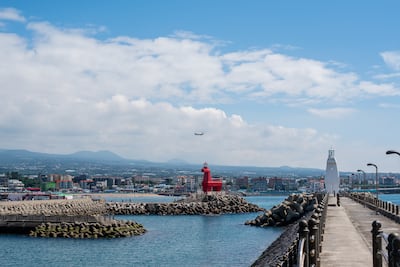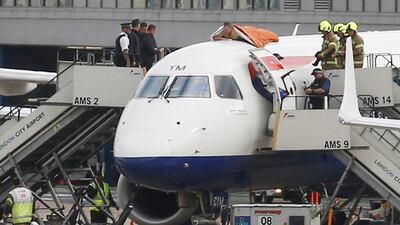Last week, activists in the Netherlands demonstrated against climate change by breaching a runway at Amsterdam Airport Schiphol and cycling across the tarmac.
Others sat in front of parked private jets or chained themselves to the aircraft to physically prevent the jets from taking off. It was all part of an "SOS for the climate" protest, designed to object to aviation industry pollution and its greenhouse gas emissions, as well as local noise pollution.
The stunt led to hundreds of arrests, but the planned protest also led to a statement from Schiphol’s chief executive conceding that a faster deadline was needed in the race against climate change.








The protesters aren’t alone. Over the last few decades, there’s been a worldwide increase in anti-airport and anti-flying movements, motivated by global climate concerns and propelled even further since the rise of the anti-flying, or flight shaming, social movement known as flygskam.
Here are six other occasions where climate activism unfolded at airports...
Protesters paint a plane green in Paris

Environmental activists from Greenpeace protested at Paris's Charles de Gaulle airport last year by painting an Air France plane.
Members of the organisation demonstrated on the tarmac in an effort to denounce the government's greenwashing of air transport. Several activists climbed the outer fence of the airport and used extendable roller brushes to apply green paint to a Boeing 777 Air France aircraft that was parked on the tarmac. There were no passengers on board at the time.
Several of the protesters also climbed onto the jet's wings, holding signs that read: “Is there a pilot to save the climate?”
Greenpeace said the government's climate measures were not ambitious enough and have called for the abandonment of several airport extension projects. In February last year, the French government announced it would cancel one of its proposed expansion plans, and ditched a project to build a new terminal at Roissy-Charles-de-Gaulle Airport.
Ongoing action against London Heathrow's third runway

Plans to expand the UK's busiest airport with a third runway have been heavily contested since they were first announced back in 2009.
The contentious project proposed a £14 billion ($16.14bn) expansion to Europe’s busiest airport, including adding a third runway, extensions to Terminals 2 and 5, and a new mammoth car park. The works would involve rerouting roads, diverting rivers and demolishing an entire village.
Environmental groups criticised the idea of a third runway due to the increase in carbon emissions that would come from more flights. Protests from several groups and campaigners have taken place over the years with one of the most dramatic taking place in 2016 when protesters lay on the floor at Heathrow pretending to be dead.
Set up by climate group Reclaim the Power, the peaceful protest saw hundreds of activists laying lifeless in Terminal 2, while others read testimonies from communities that have been affected by climate change, and urged holidaymakers to think about the impact of their flight on the environment. They said the “problem isn’t being caused by business or normal families taking a holiday, but a wealthy elite ‘binge flying’, often to second homes".
Subsequent protests saw campaigners blocking roads to Heathrow, cutting holes in airport fences and chaining themselves together on the runway. The outcry has been partly successful, with campaigners winning a 2020 court case against the expansion after a judge ruled it illegal, but the verdict has since been overturned. However, plans are still on pause and the original 2026 deadline has been pushed back to 2030 at the earliest.
Disharmony on South Korea’s 'Island of Peace'

On the egg-shaped island of Jeju in South Korea, also known as the Island of Peace, protesters have been voicing concerns against plans for a second airport since 2015.
Seven years ago, the government revealed it wanted to turn a former air force base in Seongsan into a 500-hectare airport. Its development would mean many locals would lose their homes, farmers would be kicked off their land and indigenous communities’ sacred sites destroyed.
For several years, locals and activists have regularly gathered on the proposed airport land to force home their point. Others have carried out hunger strikes. Local people, rights groups and environmentalists have been involved in the protests, saying that the plans for the second airport will destroy the island's natural environment and adversely affect villagers.
The island is already home to Jeju International Airport, the second-largest airport in South Korea after Seoul-Incheon. Pre-pandemic, it was already operating at maximum capacity. However, those against the second airport say the existing Jeju International Airport can cater to a rising number of passengers, so long as it is revamped with improved facilities and runways.
The continuing objections have meant that despite pledging $4 billion dollars to the project, development work at the second airport remains halted.
Extinction Rebellion arrests at airports in Sweden
Sixteen environmental activists from Extinction Rebellion Sweden were arrested for protesting at eight Swedish airports last year.
Their actions, which caused several flight delays, were organised as a way to ask Swedish authorities to stop subsidising the aviation sector.
The group carried out various protests including standing in front of a plane at an airfield in Sturup, acting as passengers on a plane at Landvetter and refusing to sit down, and climbing onto the runway at Vaxjo Smaland Airport and gluing their hands to the tarmac.
The duo who carried out the latter actions were subsequently sentenced to two months in prison, the first time climate activists from Extinction Rebellion Sweden have been sentenced to prison for peaceful civil disobedience.
Activists climb on a plane at London City Airport

In 2019, as part of a series of protests at London City Airport by Extinction Rebellion, a man climbed on top of a plane, others glued themselves to the terminal and more tried to “take over” the hub with a sit-in protest.
James Brown, para-athlete turned environmental activist, climbed on top of a British Airways jet that was parked on the runway. He remained there for almost an hour as authorities attempted to coax him down.
The stunt was part of Extinction Rebellion's plans to shut down London's fifth largest and most central airport as a protest against the planned expansion of the site, which the group said will make it “impossible” for the government to reach carbon-neutral status by 2050. A large police presence around the airport prevented the takeover from happening, although hundreds of activists did block the main entrances. Several arrests were made and campaigners warned that “no one should be fooled by attempts to ‘greenwash’ aviation".
Other campaigners ensured a flight was delayed by acting as a passenger and giving a lecture on climate change just before take-off. Standing up in the middle of the aisle of an Aer Lingus flight to Dublin, the passenger read the speech aloud from his phone as it was preparing to leave.
He ignored the crew who asked him to sit down and was eventually escorted off the jet by police, resulting in the flight departing two hours behind schedule.
Long-running airport protests in France
One of the longest-running anti-airport struggles happened in France over a period of more than 40 years.
In the 1960s, plans for a “Great West” transatlantic gateway to Europe were revealed by French authorities, with the Notre-Dame-des-Landes site near Nantes identified as the place where the airport would be built. The project subsequently stalled but was revived many years later much to the dismay of climate activists and local farmers.
In 2012, riot police sent to clear the site pulled back after events turned violent. In February 2014, on the fringes of a larger demonstration in Nantes, about 1,000 radical environmentalists smashed shop windows and trashed the local offices of Vinci, the contractor on the airport project in nearby Notre-Dame-des-Landes.
Two years later, thousands of protesters staged a huge demonstration at the site of Notre-Dame-des-Landes and more than 300 campaigners remained squatting on the land there to prevent any development. Finally, in 2018, after decades of anti-airport struggle, France's then-prime minister Edouard Philippe announced the plan had been abandoned and that the government would instead focus resources on modernising the existing Nantes airport.
In 2020, Extinction Rebellion activists in France invaded the runway as Paris's Orly Airport reopened after being closed owing to Covid-19. The activists lit flares and attached themselves to bicycles with locks around their necks in protest of the government's €15 billion ($15.1bn) bailout of the aviation industry, which suffered huge losses with the grounding of air traffic during the pandemic. According to the organisation, 29 people were arrested by authorities.


